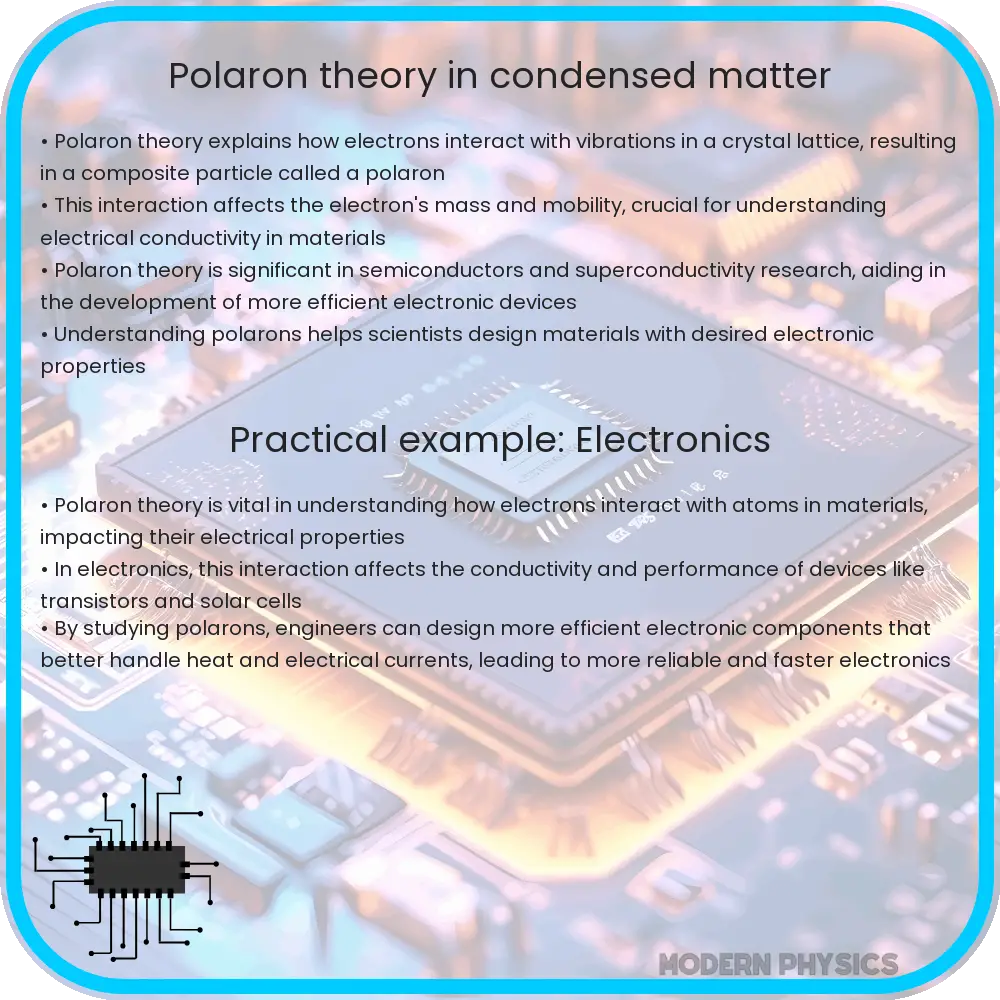The realm of condensed matter physics is a beautifully complex domain where particles interact in ways that challenge our understanding of fundamental physical principles. Among the myriad entities that populate this field, the polaron emerges as a particularly captivating character—a molecular shape-shifter wrestling with an identity crisis. To unravel the mystery of what defines a polaron, one must traverse the intricate landscapes of quantum mechanics and solid-state physics, where the line between matter and excitation begins to blur.
A polaron can be thought of as an electron (or hole) surrounded by a cloud of lattice distortions in a crystalline environment. This phenomenon arises when the electron interacts with the phonons, the quasiparticles responsible for the quantized vibrational modes in solids. The thermal motion of atoms in a crystalline lattice alters the local electronic environment, creating a region of altered potential energy. This intricate dance results in the formation of a self-trapping entity—the polaron, which combines both electronic and phononic characteristics, thus embodying the duality of its nature.
Historically, the concept of a polaron has its roots in early 20th-century physics, inspired by seminal work in the study of superconductivity and dielectric materials. The term was coined by the physicist Lev Landau in 1933, yet the nuances of the polaron concept have evolved significantly. Early models depicted polarons largely in a simplistic framework, but contemporary research has revealed complexities that challenge those foundational notions, allowing for the emergence of diverse polaron types with distinct properties.
One might liken a polaron to a ghostly figure navigating a crowded ballroom. While the electron is the dancer, the surrounding lattice distortions act as the music that influences the dancer’s movements. However, just as a ghost cannot be seen without the colors and textures of the ballroom, the polaron cannot be fully understood without acknowledging its phononic entourage. This interplay is intrinsic to the polaron’s identity—its essence is shaped by its interactions with the surrounding environment, making it an entity that defies simple categorization.
Two primary categories of polarons are distinguished: small polarons and large polarons. Small polarons, tightly bound states, form when the electron is significantly localized due to strong interaction with the lattice. In this case, the electron effectively adopts the characteristics of a phonon field, resulting in a strong coupling regime. The conceptual beauty of small polarons lies in their ability to hop from site to site within the lattice, a process governed by quantum tunneling, which allows for efficient conductivity in certain materials, often leading to phenomena like thermoelectric effects.
Conversely, large polarons exist in weaker coupling regimes, where the electron experiences only modest lattice distortions. Here, the electron remains more delocalized, resembling a “wave” that flows through the solid instead of a confined “particle.” This distinction is crucial, as it significantly affects electrical transport properties and can lead to intriguing phase transitions, particularly in complex materials such as high-temperature superconductors. The large polaron is a metaphorical traveler, exploring vast territories, while the small polaron hones in on specific locales, guided by a firm connection to its phononic associates.
The unique identity and appeal of polarons extend beyond their electronic properties; they play pivotal roles in a variety of applications, from semiconductors to superconductors and even in the burgeoning field of organic electronics. Polaronic effects can influence energy transfer processes in molecular systems, where the manipulation of charge carriers is paramount for achieving efficient device performance. The marriage of polarons with nanostructured materials represents a frontier of materials science—a fusion of classical and quantum phenomena where the rules of the game transform under the conditions of confinement and dimensionality.
Moreover, experimental techniques such as spectroscopy and electron microscopy have unveiled the complex realities of polaron dynamics, enabling scientists to visualize their behavior and interactions within materials. Such insights not only enhance our understanding of fundamental physics but also inspire innovations in technology, where manipulating polaron behavior could lead to advances in energy conversion processes and computational applications.
From a theoretical perspective, the study of polarons offers a rich tapestry of challenges. Theoretical frameworks, such as the Frohlich model and the Holstein model, are pivotal for describing their formation and transport properties. However, as materials become more complex, the need for refined models incorporating many-body effects and disorder becomes increasingly apparent. These challenges echo the broader themes of uncertainty and complexity that permeate the landscape of condensed matter physics, as researchers continually attempt to reconcile theory with experimental findings.
As we navigate the intricate interplay of particles and their environment, the polaron stands as a testament to the rich, often perplexing nature of condensed matter systems. This particle, caught in an identity crisis, embodies the duality of wave and particle while highlighting the profound impact of collective interactions within solids. Just as one must question the identity of a ghost amidst the vibrant ballroom, one must also ponder the classification of polarons—entities that dance between the realms of individual particles and collective excitations. The study of polarons not only enriches our understanding of material behavior but also beckons us to explore the enchanting mysteries that lie within the heart of condensed matter physics.








